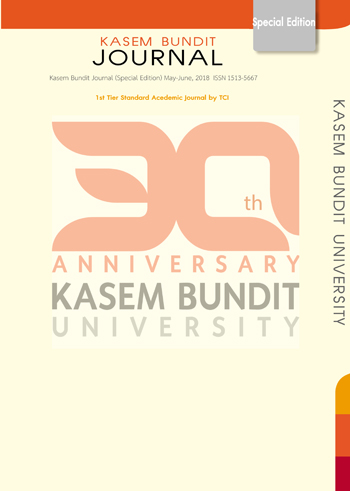A comparison of statistical techniques in predicting violent outcomes in Thailand’s deep South
Keywords:
logistic regression, decision tree, Thailand’s deep South, violent outcomesAbstract
The classification of violent outcomes helps monitor their causes to prevent further loss among the public. The ability of statistical techniques to accurately predict the outcomes needs to be investigated. This study applied logistic regression (LR) and chi-squared automatic interaction detection decision tree (CHAID) techniques to predict physical and non-physical injuries which are considered violent outcomes. A set of 21,424 data about violent events from 2004 to 2016 were obtained from the Deep South Coordination Centre database and were divided into, and used as, training and testing datasets. Nine significant predictors, including arson, gun, bomb, time, province, day, quarter, zone, and district, were identified by LR as predicting violent outcomes. Likewise, only five factors, gun, zone, bomb, time, and arson, were represented in the CHAID results. However, the performances of LR and CHAID were not significantly different in terms of overall classification accuracy and area under the receiver operating characteristic curve.
References
[2] The world medical association, inc. (2012). WMA statement on violence in the health sector by patients and those close to them. Adopted by the 63rd WMA General Assembly, Bangkok, Thailand, October 2012. Available from URL: https://www.med.or.jp/jma/jma_infoactivity/jma_activity/2012wma/2012_06e.pdf [Accessed 2018 Mar.]
[3] Morris, S. C. (2007). The Causes of Violence and the Effects of Violence On Community and Individual Health. Global Health Education Consortium. September 2007.
[4] Burke, A., Tweedie, P., & Poocharoen, O. (2013). Understanding the Subnational Conflict Area.The Contested Corners of Asia: Subnational Conflict and International Development Assistance The Case of Southern Thailand, (p11–24). The Asia Foundation,San Fransisco, CA, U.S.A.
[5] Sabur, M. A. (2017). Minorities in Thailand and current Issues. Available from URL:https://www.iiipeace.org/Southern%20Thailand%20Present%20Situation%20and%20Its%20Impact%20by%20Abdus%20Sabur%2005_07_12.htm [Accessed 2017 Jan.]
[6] Chirtkiatsakul, B., Kuning, M., McNeil, N., & Eso, M. (2014). Risk Factors for Mortality among Victims of Provincial Unrest in Southern Thailand. Kasetsart J. (Soc. Sci), 35, 84 - 91 (2014)
[7] Marohabout, P. , Choonpradub, C., & Kuning M. (2009). Terrorism Risk Modeling in Southern Border Provinces of Thailand during 2004 to 2005. Songklanakarin J. of Social Sciences & Humanities, 15(6), 883-895.
[8] Khongmark, S., & Kuning, M. (2013). Modeling Incidence Rates of Terrorism Injuries in Southern Thailand. Chiang Mai Journal of Science, 40(4), 743-749.
[9] Inyaem, U., Haruechaiyasak, C., Meesad, P., & Tran, D. (2010). Terrorism Event Classification Using Fuzzy Inference Systems. International Journal of Computer Science and Information Security, 7( 3), 247-256.
[10] Kengpol, A., & Neungrit, P. (2012). A Prediction of Terrorist Distribution Range Radius and Elapsing Time: A Case Study in Southern Parts of Thailand. Proceedings of Intelligence and Security Informatics Conference (EISIC), 2012 European, Odense, 180-188. doi: 10.1109/EISIC.2012.19
[11] Kengpol, A., & Neungrit, P. (2014). A decision support methodology with risk assessment on prediction of terrorism insurgency distribution range radius and elapsing time: An empirical case study in Thailand. Computers & Industrial Engineering, 75, 55-67.
[12] Delen, D., Walker, G., & Kadam, A. (2005). Predicting breast cancer survivability: a comparison of three data mining methods. Artificial Intelligence in Medicine, 34, 113-127.
[13] Yu, Y.-W., Chao, C.-M., Cheng, B.-W., & Kuo, Y.-L. (2009). Predicting breast cancer survivability: a comparison of three data mining methods. Proceedings of Asia Pacific Industrial Engineering & Management Systems Conference. 14-16.
[14] Long, W.J., Griffith, J.L., Selker, H. P., & D’Agostino, R.B. (1993). A comparison of logistic regression to decision tree induction in a medical domain. Computers in Biomedical Research, 26, 74-97.
[15] Zurada, J., & Lonial, S. (2005). Comparison of the performance of several data mining methods for bad debt recovery in the healthcare industry. The Journal of Applied Business Research, 21, 37-53.
[16] Liu, Y.Y., Yang, M., Ramsay, M., Li, X.S., & Coid, J.W. A Comparison of Logistic Regression, Classification and Regression Tree, and Neural Networks Models in Predicting Violent Re-Offending. J Quant Criminol. doi: 10.1007/s10940-011-9137-7
[17] Rudolfer, S.M., & Peers, I.S. (1999). A comparison of logistic regression to decision tree induction in the diagnosis of carpal tunnel syndrome. Computer and Biomedical Research, 32, 391-414.
[18] Badriyah, T., Briggs, J. S., & Prytherch, D. R. (2012).Decision trees for predicting risk of mortality using routinely collected data. International Journal of Social and Human Sciences, 6, 303-306.
[19] Hosmer, D.W., & Lemeshow, S. (2000). Applied logistic regression (2nd ed.). New York, New York, USA: A Wiley-Interscience Publication, John Wiley & Sons Inc.
[20] Song, Y.-Y. & Lu, Y. (2015). Decision tree methods: applications for classification and prediction. Shanghai Arch Psychiatry, 27(2), 130-135. doi: https://dx.doi.org/10.11919/j.issn.1002-0829.215044
[21] Milanovic, M., & Stamenkovic, M. (2016). Chaid decision tree: methodological frame and application. Economic Themes, 54(4), 563-586. doi: 10.1515/ethemes-2016-0029
[22] CHAID and Exhaustive CHAID Algorithms. Available from URL:ftp://ftp.software.ibm.com/software/analytics/spss/support/Stats/Docs/Statistics/Algorithms/13.0/TREE-CHAID.pdf
[23] Fawcett, T. (2006). An introduction to ROC analysis. Pattern Recognition Letters, 27, 861- 874.
[24] Gajowniczek, K., Ząbkowski, T., & Szupiluk, R. (2014). Estimating the ROC curve and its significance for classification models’ assessment. Quantitative Methods in Economics, 15(2), 382 -391.
[25] Hajian-Tilaki, K. (2013). Receiver Operating Characteristic (ROC) Curve Analysis for Medical Diagnostic Test Evaluation. Caspian Journal of Internal Medicine, 4(2), 627-635.
[26] Kuning, M., Eso, M., Sornsrivichai, V., & Chongsuvivatwong, V. (2014). Epidemiology of the Violence in the Deep South. In Chongsuvivatwong,V., Boegli, L. C. & Hasuwannakit, S (Eds). Healing under fire the case of southern Thailand (pp. 41-49). The Deep South Relief and Reconciliation Foundation and the Rugiagli Initiative, Thailand, Bangkok.
[27] Xiong, H., Pandey, G., Steinbach, M., & Kumar, V. (2006). Enhancing data analysis with noise removal. IEEE Transactions on Knowledge and Data Engineering, 18(3), 304-319.
[28] Peleg, K., Daniel, L., & Stein, M. (2004). Gunshot and explosion injuries characteristics, outcomes, and implications for care of terror-related injuries in Israel. Annals of Surgery, 239(3), 311-318.
[29] Pusponegoro, A. D. (2003). Terrorism in Indonesia. Prehospital and Disaster Medicine, 18(2), 100-105.
Downloads
Published
How to Cite
Issue
Section
License
ทัศนคติ ความคิดเห็นใด ๆ ที่ปรากฏในวารสารเกษมบัณฑิตฉบับนี้เป็นของผู้เขียน โดยเฉพาะ มหาวิทยาลัยเกษมบัณฑิตและบรรณาธิการ ไม่จำเป็นต้องมีความเห็นพ้องด้วย







